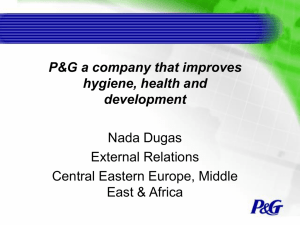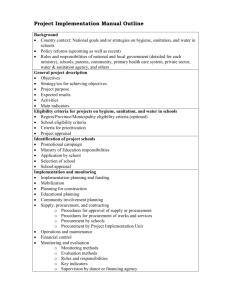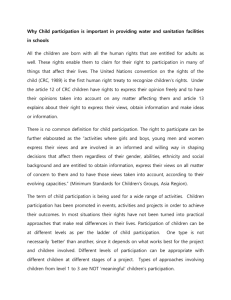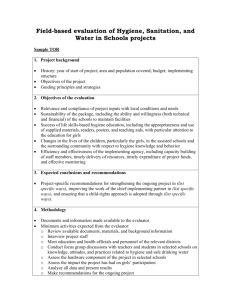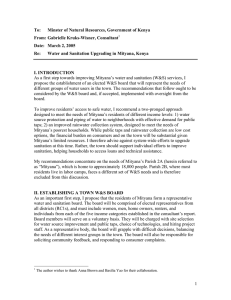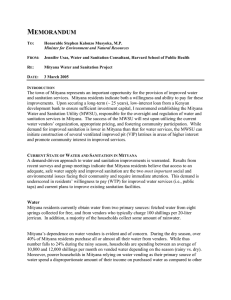MEMORANDUM To: Kenya Minister of Natural Resources
advertisement
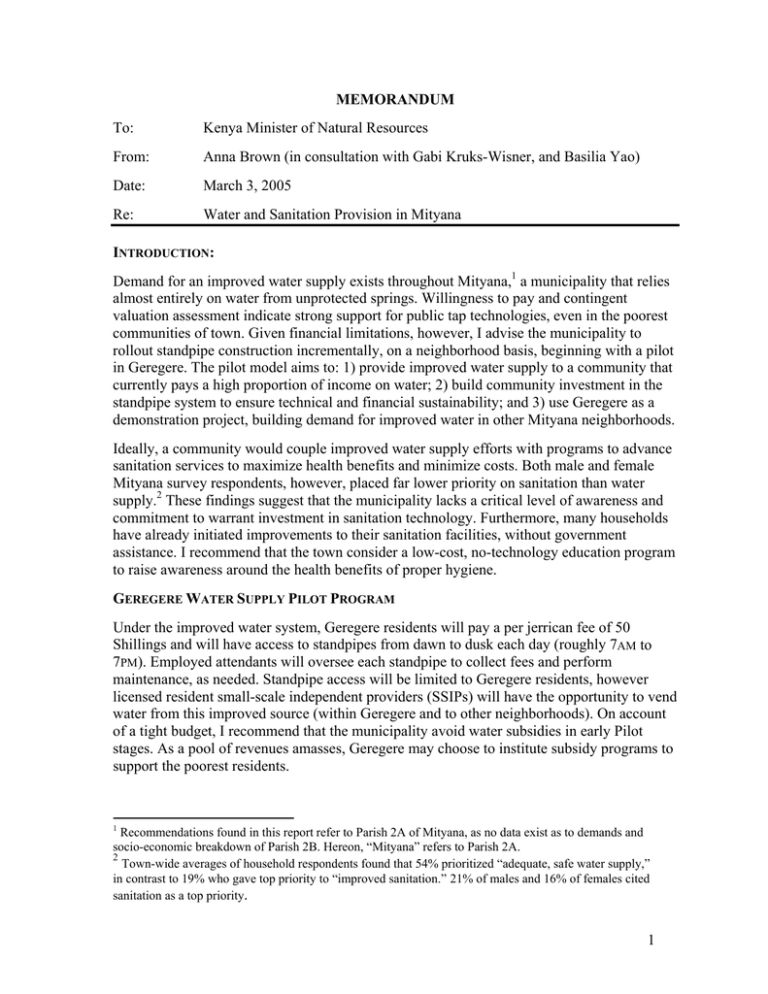
MEMORANDUM To: Kenya Minister of Natural Resources From: Anna Brown (in consultation with Gabi Kruks-Wisner, and Basilia Yao) Date: March 3, 2005 Re: Water and Sanitation Provision in Mityana INTRODUCTION: Demand for an improved water supply exists throughout Mityana,1 a municipality that relies almost entirely on water from unprotected springs. Willingness to pay and contingent valuation assessment indicate strong support for public tap technologies, even in the poorest communities of town. Given financial limitations, however, I advise the municipality to rollout standpipe construction incrementally, on a neighborhood basis, beginning with a pilot in Geregere. The pilot model aims to: 1) provide improved water supply to a community that currently pays a high proportion of income on water; 2) build community investment in the standpipe system to ensure technical and financial sustainability; and 3) use Geregere as a demonstration project, building demand for improved water in other Mityana neighborhoods. Ideally, a community would couple improved water supply efforts with programs to advance sanitation services to maximize health benefits and minimize costs. Both male and female Mityana survey respondents, however, placed far lower priority on sanitation than water supply.2 These findings suggest that the municipality lacks a critical level of awareness and commitment to warrant investment in sanitation technology. Furthermore, many households have already initiated improvements to their sanitation facilities, without government assistance. I recommend that the town consider a low-cost, no-technology education program to raise awareness around the health benefits of proper hygiene. GEREGERE WATER SUPPLY PILOT PROGRAM Under the improved water system, Geregere residents will pay a per jerrican fee of 50 Shillings and will have access to standpipes from dawn to dusk each day (roughly 7AM to 7PM). Employed attendants will oversee each standpipe to collect fees and perform maintenance, as needed. Standpipe access will be limited to Geregere residents, however licensed resident small-scale independent providers (SSIPs) will have the opportunity to vend water from this improved source (within Geregere and to other neighborhoods). On account of a tight budget, I recommend that the municipality avoid water subsidies in early Pilot stages. As a pool of revenues amasses, Geregere may choose to institute subsidy programs to support the poorest residents. 1 Recommendations found in this report refer to Parish 2A of Mityana, as no data exist as to demands and socio-economic breakdown of Parish 2B. Hereon, “Mityana” refers to Parish 2A. 2 Town-wide averages of household respondents found that 54% prioritized “adequate, safe water supply,” in contrast to 19% who gave top priority to “improved sanitation.” 21% of males and 16% of females cited sanitation as a top priority. 1 The need is great Though one of the poorer neighborhoods of Mityana, Geregere residents currently spend a high proportion of their income on water. The Pilot will allow Geregere residents to obtain safer and less costly water,3 freeing up household income among residents currently relying on vended water. Improved water may also translate to a reduced risk of water-related/ water-borne disease, thereby decreasing medical expenditures and lost labor hours. Demand for standpipes among Geregere residents Survey data indicates that 95% of Geregere respondents are willing to pay 50 Shillings/ jerrican of water from public taps. No other neighborhood surveyed demonstrated this level of support for standpipes. Even at a higher price of 100 Shillings/jerrican, Geregere survey respondents indicated the greatest willingness to pay (63%), of all Mityana neighborhoods. In contrast to private household connections, standpipes offer a relatively affordable source of improved water. Even poor neighborhoods like Geregere and Kinyoro demonstrated a high willingness to pay for water at 50 Shillings/jerrican. Residents may continue to rely on spring water under this program. Building a local economy Under the Pilot, Geregere SSIPs will have an opportunity to market quality water to other neighborhoods, providing a community revenue source. Furthermore, since only about one third of vendors interviewed were born in Mityana, the Geregere Pilot supports economic ventures of Mityana residents. I recommend launching the Pilot in Geregere, rather than Central, a neighborhood more dependant on vended water, to allow SSIPs a larger market for improved water. In providing standpipes to Central, SSIPs throughout the town would lose a significant market share. In the future, additional finances could help Mityana provide retraining programs to assist SSIPs in finding other work, should vended water markets diminish further. INSTITUTIONALIZING IMPROVED WATER Today, broken boreholes and pumps, and poorly maintained latrines in Mityana indicate past failures to create institutions that sustain long-term water supply and sanitation solutions. Create a Geregere Water and Sanitation Committee I recommend the creation of a quasi-governmental Geregere Water and Sanitation Committee to: ♦ Hire, oversee, and fire standpipe attendants ♦ Organize trainings to build technical capacity for standpipe maintenance and hygiene education ♦ Oversee operation and maintenance schedules ♦ Oversee payment to Committee staff (including standpipe attendants) 3 Based on the current vended water price of 100 Shillings/jerrican. 2 Decentralized management models can help improve the accountability of service providers to users, as outlined by Parkinson and Taylor in the context of wastewater management (2003). In anticipation of future neighborhood-based water supply programs, I advise the Town Council to maintain rights to fiscal audits, water quality testing, and intervention based on unmet community concerns. This oversight will help prevent fragmentation, a potential risk of decentralized services. It also provides a check-and-balance system to ensure that water supply (and sanitation, when introduced) needs are efficiently and equitably met. The administrative segment of the Committee will include a minimal but essential paid staff (see Table 1 for Roles and Responsibilities). TABLE 1: Geregere Water and Sanitation Committee Roles and Responsibilities POSITION Director Technical Expert Administrator Hygiene Educator* RESPONSIBILITIES Vision, focal point for community Liaison to Community Board Oversight Training in construction, operation, and maintenance Operations and maintenance scheduling and point person Oversight of water quality spot tests Payroll, budgetary planning and administration General administration Hygiene education, training, and outreach Standpipe Attendants User fee collection Operation and maintenance, water quality testing *This position is initially contingent upon the Town Council allocating funds from vendor license fees. Form Community Board for Support, Guidance, and Endorsement A strong Community Board comprised of representatives “networked” within the social fabric of Geregere will provide a mechanism to facilitate information exchange among neighborhood residents and the Committee. Fieldwork from Semarang, Indonesia, an urban setting, highlights the value of neighborhood-level planning, an approach taken in the Geregere Pilot (Whittington et al., 2000). Board members will play a critical role in advising the Committee based on neighborhood needs. The Board will also help resolve disputes and provide a means for redress, where needed. Likewise, the Board will help galvanize community investment and support for standpipe construction and operation. Community Board members will not, as a rule, receive compensation. To ensure that all community members have a voice in decision making, especially residents typically disenfranchised, I urge the Board to incorporate as members: women and men from different social classes, renters and owners, business leaders (including water vendors), health care professionals, educators, and the RC1 Chairperson. FINANCING IMPROVED WATER Where possible, I urge the Geregere Water Supply Pilot program to draw upon local resources and labor to minimize costs and build community investment in the project. The fee structure for standpipe use, 50 Shillings/ jerrican, will provide the means to cover the typical cost of $5 per household/ month for each standpipe. This rate will also cover other 3 administrative costs (see Table 2 for Water Supply Pilot Pricing). Still, the Pilot requires start-up monies for training, construction, and administration. The following strategies offer mechanisms to galvanize start-up funds for this low-income neighborhood: ♦ Draw upon Community Board influence to spark financial investments from households able to pay (e.g. $1 per household), as well as unskilled labor and materials commitments to defray construction costs ♦ Solicit small loans from SSIPs, with interest rate returns of 10 per cent ♦ Apply for micro-credit grants, where needed, using organizations like the Kenyan Rural Enterprise Programme (K-REP) TABLE 2: Water Supply Pilot Pricing Operation & Maintenance Costs 20 Standpipe Attendants @$0.20/hour (based on 84 hour work week) Committee Director @ 0.40/hour (based on 40 hour work week) Committee Administrator @0.35/hour (based on 40 hour work week) Technical Expert- part time @o.40/hour (based on 20 hour work week) Total Expenditures Costs (USD/Month) ($1344) ($64) ($56) ($32) ($1496) Income from User Fees 491 Households (based on 4 jerricans/household per day @50 Shillings (=$0.053UDS)/ jerrican) Total Revenues Revenue $3122.76 $3122.76 Surplus $1626.76 * Based on calculations of 25 households per standpipe ** Figures based on an estimate of 2600 residents in Geregere with average household size of 5.3 people Æ calculated number of households= 491 ***Based upon conversion 950 Shillings=$1.00USD, as cited in An Assessment of Water Supply and Sanitation Conditions and Demand for Improved Services in Mityana, Kenya, August 1997 HYGIENE EDUCATION PROJECT While the Water Supply Pilot targets Geregere, I recommend that hygiene education expand to the broader 2A Parish community, with a particular focus on youth. As few-to-zero revenue-generating opportunities exist in relationship to hygiene promotion, the program must, at this stage, depend entirely upon existing resources. Example materials include publications from the WASH-Water, Sanitation and Hygiene for All campaign (Water and Sanitation Collaborative Council). Community members with health-related knowledge and contact with youth also serve as important assets. Countless examples of community driven health education programs exist from around the world, including the work of Sulabh International in Madras, India. Health care providers will first offer hygiene education and training to educators, religious leaders, and local organizations. Workshops will include brainstorming to develop compelling approaches to present the benefits of proper hygiene. After undergoing training, educators and other community leaders will lead activities in schools, churches, and other similar settings to improve hygiene practices among young people. 4 Mandate hygiene education in schools The Mityana Town Council has a tremendous opportunity for far-reaching hygiene education by requiring all schools to incorporate a hygiene curriculum into the course program. This action also opens up other potential funding avenues, including the Departments of Heath and Education. Young people as important focal point for hygiene outreach 1. Easy Access: Schools offer a setting in which hygiene educators can reach many people in one location, with the potential for regular meetings 2. Malleability: Young people have a greater likelihood of adopting new habits, which may then be passed on to their children 3. Household Entry: Youth provide a point of entry into households and may help influence broader household hygiene behavior. Potential hygiene-related entrepreneurial activities Heightened attention to the importance of good hygiene practices creates opportunities for Mityana residents, particularly women, to establish small-scale soap making enterprises. Start-up funds could originate from loans from within the community (e.g. from water vendors) or as part of a revolving loan fund established with vendor license or water user fees (the latter, in the case of Geregere). I strongly urge the Town Council to earmark water vendor license fees for hygiene outreach. Other micro-credit organizations exist in Kenya and offer other potential start-up funds for entrepreneurial endeavors. LOOKING AHEAD The Geregere Water Supply Pilot program offers a small-scale decentralized model of water service provision in a low-income segment of a small town. As the project unfolds, I anticipate that it will offer valuable insights related to how institutional frameworks can support (or impair) technical, social, and financial longevity with regard to water supply and hygiene education. Key design points to consider in water supply and sanitation plans for secondary towns: ♦ Capitalize on existing social resources (e.g. community leaders as means to galvanize interest, investment, and support for improved water supply and hygiene education) ♦ Where possible, bring system of authority and oversight to a level as close to the ground as possible, maintaining the ability to provide effective governance structures ♦ Utilize demonstration projects to create a “network effect” and build demand in other neighborhoods/communities. ♦ Where possible, address water supply and sanitation needs in tandem. ♦ Balancing user preferences with longer-term planning: I have recommended a fee structure that demands payment per amount of water used in spite of high demand for a flat monthly rate. This model promotes water conservation and anticipates increased future water use (e.g. through household connections); it habituates communities to conservation now to avert potential social strife later. 5
